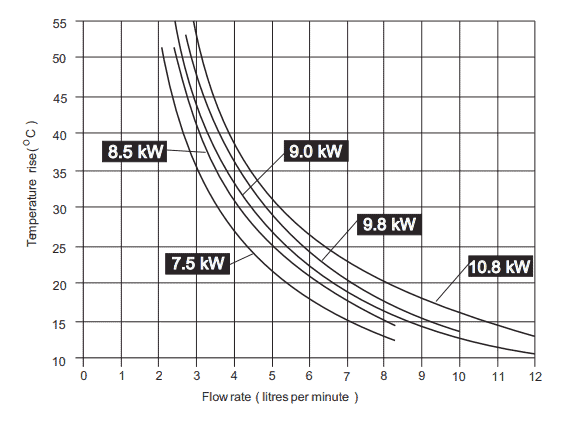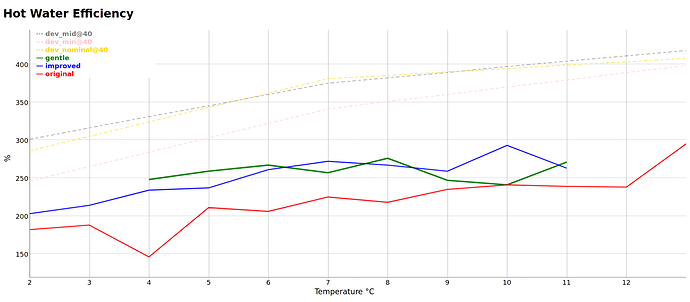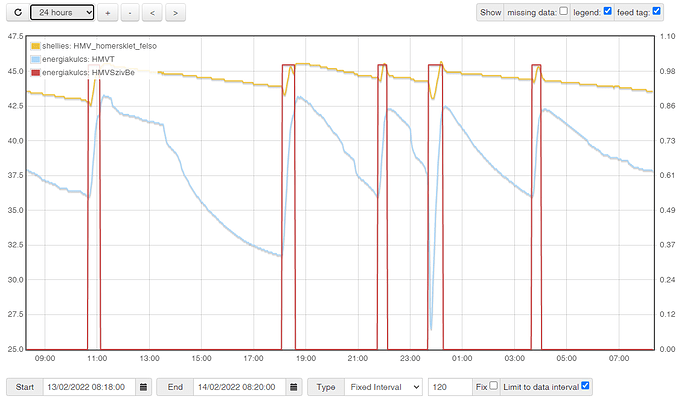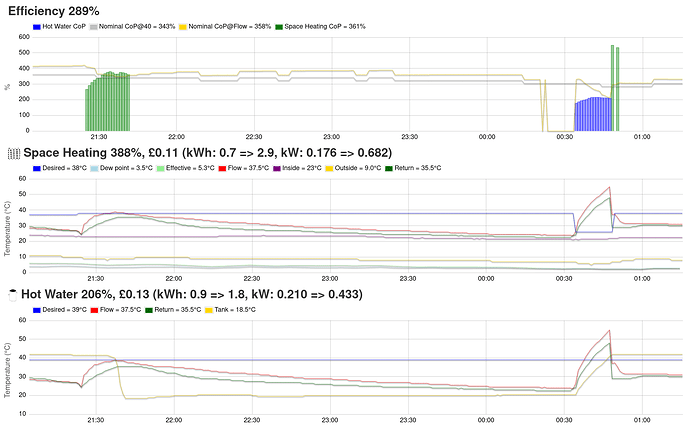Well, you’ve made me investigate what our system is doing @christian
The bottom of our hot water tank drops almost to the “incoming cold water temp” when someone has a shower. So in this case that’s about 14 °C:
How is your tank starting out at 44 °C? Is that the reading from the top of your tank?
In other news you can see how our Ecodan is getting very excited, even in Eco mode, and is pushing the flow up to 55 °C so that the tank gets to 45 °C. I wish it would just be a lot more relaxed.
That chart is showing the replenish after a single shower. It used 1.2kWh input and produced 2.8kWh output. An electric shower is about 10kW and the people here shower for about 10 minutes so that would be about 1.6kWh required output. So clearly we’re using a lot of power to re-heat the hot water tank which isn’t good - you’d hope it would be 1.6kWh or less output (and consequently less input too).
However, our four-person house is using way more power than you to heat water…the last month was 167kWh so even that month (at 24GBP) was almost as much as your annual cost. We’re pretty much only using hot water for bathing.
You are using 6 °C * 250L * 4kJ/L/°C = 6,000kJ = 1.67kWh of output per day. So that’s about half the output of a single shower here.
Bear in mind I removed the power shower (16L/min) and we’re on the mains pressure now which gives about 12L/min. We measured it with a jug so it’s empirically 12L/min, not just a number from a guide.
Seeing as you are having two showers a day that’s 0.8kWh output per shower. That would be 4.8 mins with an electric shower so I’m assuming you are taking sensible-length showers.
As another example, here’s a time when the tank went down from 44 °C to 9 °C using two showers and was then pushed back up by the heat pump. That shows we used 6.2kWh output for those two long showers which would be the equivalent of running an electric shower (10kW) for 37 minutes!
I just measured our shower (37 °C) and incoming water (7 °C). So, for instantaneous heating we would need a 30 °C uplift at 12L/min = 30 °C * 12L/min * 4kJ/L = 30 °C * 0.2L/s * 4kJ/L = 24kW. That would be 100A using 240V in the UK! Here in the UK most houses are supplied with between 60A and 100A.
It turns out an instantaneous electric shower would simply not be capable of doing this:

So, as @borpin says, you’d need to start with warm water. If we take the 10kW inline heater as an example, it would be able to raise a 12L/min flow by about 13 °C. So we’d need a store of water where we’d already come up from 7 °C mains up to 24 °C. That sounds like ideal heat pump territory.
Now the interesting bit. An inline heater would be 100% efficient. However our heat pump is over 200% efficient. Arguably it’s much, much more expensive to build though.
Here’s that “double shower” re-heat run from above viewed from the perspective of the heat pump heating up the DHW.
You can see it got down to around 200% efficient as it got to the end and the tank water got up to 44 °C.
I actually run the hot water at 42 °C most of the year but it gets boosted to 44 °C in the Winter to be prepared in case someone comes back chilled-to-the-bone and needs a boost. However, I just spoke to the primary need person and they are happy it’s plenty warm enough so I think I’ll drop the target temp and see if that helps.
Looking back at the Summer is so weird. For example, it looks a lot happier on this run which was only one of four in the entire week (versus three or four a day in the Winter). It has far less work to do and the air is so much warmer. Summer is nice 
When it’s cold all the “losses” from the hot water tank actually heat up the utility room where we chose not to have a radiator so they aren’t really “losses”. When it’s warm it doesn’t lose so much (smaller deltaT) and there’s much more heat available so I’m not so worried about those losses.
It’s actually the same with the pipe runs to the shower. I don’t mind that water being wasted in the pipes because it’s “poor person’s underfloor heating” and the heat is lost (mostly) into the lived-in spaces.











